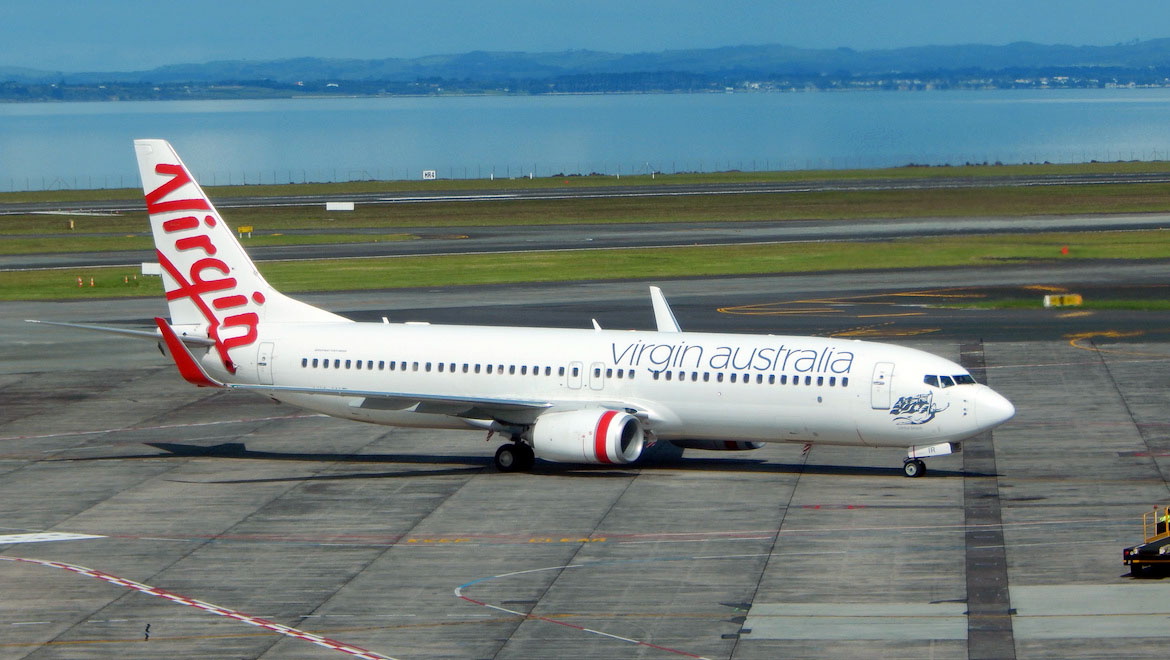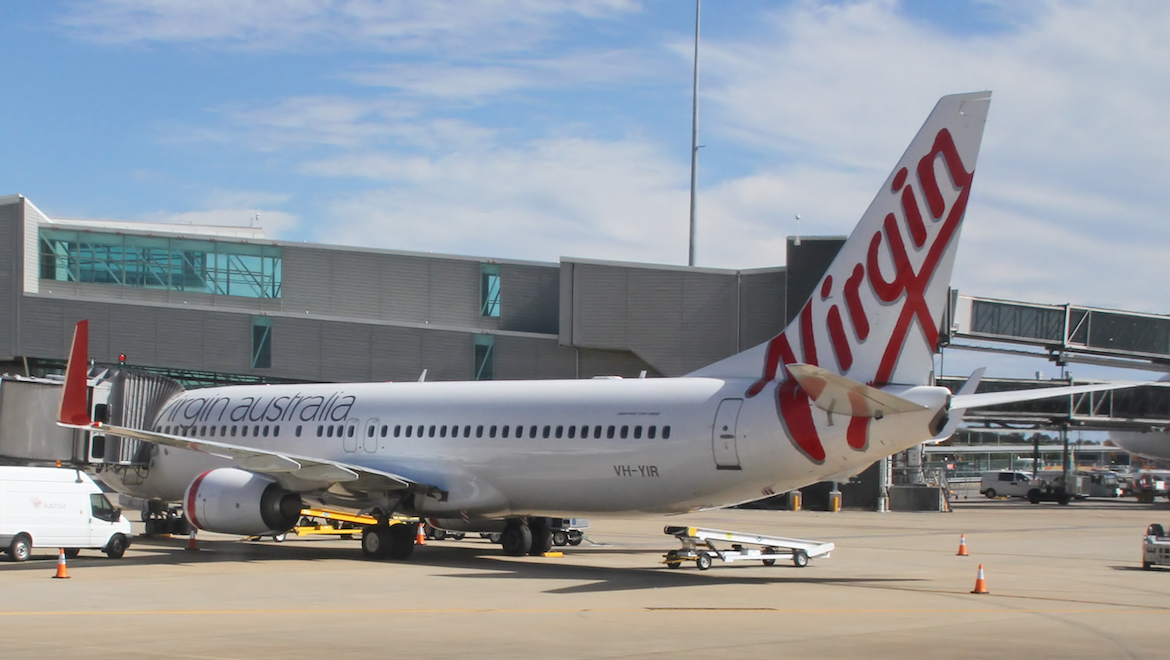
A Virgin Australia Boeing 737-800 suffered a tailstrike on takeoff from Auckland Airport after a reduction in headwind resulted in a drop in airspeed, an Australian Transport Safety Bureau (ATSB) investigation has found.
The incident occurred on January 17 2018, when 737-800 VH-YIR was operating flight VA91 to Rarotonga in the Cook Islands.
The ATSB final report published on Thursday said the takeoff had occurred in gusty conditions – including a slight crosswind – with the aircraft speed reducing during rotation.
“A decrease in the headwind component reduced the airspeed during rotation and extended the time required for VH-YIR to leave the runway, resulting in a reduced tail clearance and subsequent tailstrike,” the ATSB report said.
The ATSB report said an analysis of the flight data showed airspeed reduced by up to 11kt during rotation, with the pitch attitude of the aircraft at lift-off at 10.55 degrees.
Further, the data showed the aircraft “was slow to lift off the runway” at six seconds from the point of initial rotation.
“During rotation, as the aircraft continued to accelerate, a reduction in headwind resulted in an initial drop and then stagnation in airspeed until just after lift-off,” the report said.
“The airspeed variations were reportedly not identified and called out by the PM (pilot monitoring), as required in the flightcrew training manual.
“Stagnation in airspeed at rotation had a similar effect to that of rotating too early: reduced lift and an extended takeoff roll, as confirmed by the flight data.
“The continued rotation with the main landing gear remaining on the runway then resulted in a reduced tail clearance.”

The ATSB said the flightcrew felt a bump from the rear of the aircraft and concluded it was most likely the result of a tailstrike. Cabin crew reported there had been a very loud noise from the rear of the aircraft during takeoff.
The captain then contacted air traffic control to request a runway inspection, which identified no debris or damage to the runway.
After levelling off at 12,000ft, the captain then conducted an overweight landing back at Auckland Airport.
There were no injuries to the two pilots, four cabin crew and 135 passengers on board.
“The flightcrew were proactive in gathering information from all available sources, which enabled them to make a complete assessment of the situation,” the ATSB report said.
“They were decisive in their actions and kept cabin crew, passengers, ATC and ground staff up to date with clear communications.”
An engineering inspection then confirmed the aircraft had sustained a tailstrike during takeoff.
“The damage was limited to a scratch on the tailskid shoe that was found to be within the allowable limits. An overweight landing check was completed and the aircraft was determined to be serviceable,” the ATSB said.
The ATSB report said the captain noted that due to the crosswind conditions significant yoke input was required to keep the wings level.
“Even so, the aircraft became airborne with the right wing slightly lower than the left,” the ATSB report said.
“The captain noted that in strong crosswind conditions, flightcrews are required to make a quick decision on the compromise between keeping wings level and avoiding raising a spoiler, which has a corresponding loss of performance.”
Although it was discovered during the off-loading of bags and freight there were 10 fewer bags in the forward compartment of the cargo hold than detailed on the load sheet, the ATSB said this minor discrepancy was not significant and did not contribute to the tailstrike.
















Dr Hein Vandenbergh
says:This is a far from uncommon situation, hence the requirement for speed call-outs by the PNF. It reflects poor training or a very casual approach to requirements as per manual, esp when seen against the background of these weather circumstances (also not uncommon at AKL). On a runway shorter than Auckland’s this could have had quite catastrophic results.
Don
says:Crew and safety departments different at VA vs VANZ? Bit of a trend of errors here after the CHC Near over run also.
Harry
says:Dr Hein Vandenbergh, please don’t be so quick to judge. The training department and Virgin take their jobs very seriously and the crews are not “casual”. The only sloppy thing of note is your lazy assessment of a minor incident.
Cheers.
Lee
says:Wholeheartedly agree, Harry..
[email protected]
says:One possible missing fact from the findings is taking into consideration of the total weight of the 135 passengers. These flights usually have a high percentage of islanders with an average weight higher than that or more slightly built passengers. We should not forget the DC8 crash many years back in Canada with returning troups. The weight of their kits was higher than
normal baggage and not taken into Consideration. NB this post is not to be taken as offensive in any way nor was it posted to do so.
Smej
says:TD
A boot full of rudder especially during a rotate associated with gusty or crosswinds will stagnate airspeed (via pitot systems) and put you in a time position “freeze” where the elements act on you (and the aircraft). A gusty drop in wind will do the same.
NFP not calling speed variations (during sterile cockpit) is a big call if not exposed to conditions or experienced. A fine line especially when it happens quickly….only human.
Lots of possible little things as also pointed out many can’t be over trained for but exposure for future contemplation would be nice.
However, the RTB and crew work well done. That’s the bottom line. Cool bananas!
Ben
says:The comments being critical of crew coordination or perceived lack of safety/training here need to look at the situation, read the ATSB report and apply a bit of perspective.
The PM either did not recognise or could not respond quickly enough to the decay in airspeed to alert the PF. This occurred after V1, after the ‘rotate’ call and before the aircraft actually left the runway. This leaves the PM in the position of recognising the problem, thinking what to do about it and not knowing that a tail strike was going to occur until it actually happened. All this occurs in a matter of seconds. You can probably replay it several times to work out what should have happened in hindsight, but have a look at the options available:
It was a critical stage of flight with the aircraft about to become airborne. Aborting the takeoff was not an option. I’m not too sure of the required call out but if it was something along the lines of ‘airspeed variation’ or a caution to ‘not over rotate’ I’m not too sure this would have made much difference if any. By the time it was recognised, processed through the brain and communicated, the occurrence would probably have already happened.
All this aside however – the crew reacted quickly, investigated, communicated and returned to the airport. Damage was minimal and lives were not in danger. I’m not downplaying the potential seriousness of the incident, but @Dr Hein Vandenbergh to comment on it in the context of ‘poor training’ or a ‘casual’ approach to procedures is perhaps going a tad too far.
If you want an example of a near catastrophic tailstrike. Take a look at EK407 ‘departing’ Melbourne in 2009.
Also @Don to say there is a ‘trend’ of errors here after the CHC near overrun is probably taking it too far. I’ve just read the report on the CHC incident. The aircraft landed normally, all braking systems etc deploying normally and was decelerating normally. This deceleration decayed due to entering a wet section of the runway. The crew reacted to this by applying hard manual braking and leaving reverse thrust deployed for longer. Indeed had they not done this there probably would have been an overrun. I would actually say their training and reactions prevented an overrun. Hardly a trend of errors.
Hein Vandenbergh
says:Looks like a couple of explanatory comments posted by me over the weekend have gone AWOL, but I can assure the critics their comments were taken on board and addressed. However, I stand by my opinion that the PF was deprived of situational awareness through non-adherence to SOP/training on the part of the PNF, esp given the fact that (s)he would have been aware of the met conditions.
As to AK407, not ‘really’ a tail strike but inappropriately low power settings as a result of feeding incorrect a/c weight into t/o calculations, thus compromising the flight even before engine start-up – an entirely different though not uncommon scenario, but in no way relevant to this discussion – other than the fact that it involved human factors, too, though in a different way, viz their interaction with e-tech and no cross-checking.
Mike Millett
says:I am surprised that not a single comment has raised the possibility that the aircraft was overloaded. Passengers returning to Pacific Islands are usually in of a more solid build than the standard passenger weight allowance calculation figured. 135 x 10kg May explain why the wheels were still on the tarmac after rotation.
Hein Vandenbergh
says:Maybe that’s why they loaded the missing 10 bags from the fwd compartment into the rear to assist rotation!!! Dangerous ploy and it didnt work as “intended”…. These comments strictly tongue in cheek, but it remains a fact – as does the lack of speed call-outs during a critical phase of t/o. Overall, it sounds like a shambles. But Mike Millett is abs right. So many assumptions are made all the time, and sometimes they bite.
Ben
says:@Dr Hein Vandenbergh, granted the circumstances leading to EK407 were different, but that is entirely my point. That was a crew error and lack of adherence to proper monitoring and checks. There were several opportunities for the crew to check and pick up on the incorrect weight calculation but they were all missed. There was also not the adverse weather that was affecting the VA crew.
As to saying it’s not ‘really’ a tail strike. The tail section struck the runway and scrapped along it. The aircraft lifted off 148 metres beyond the end of the runway. It hit a strobe light at the end of the runway as well as a localiser antenna and barely cleared the perimeter fence. There was also damage to the rear pressure bulkhead.
I’m sorry but I don’t know how you can say that it is not ‘really’ a tail strike. Have a look at the photos in the report that show the damage to the aircraft where it scrapped along the runway.
If that isn’t ‘really’ tail strike – then I’d be horrified to see what your definition of a tail strike actually is. By that same logic, if EK407 isn’t ‘really’ a tail strike, then VA91 at Auckland sure isn’t either.
However as the saying goes ‘if it looks like a duck, swims like a duck and quacks like a duck then it probably is a duck.’ Except in this case the duck is a tail strike.
So I actually think both incidents really were tail strikes, as evidenced by what is written in both ATSB reports. My point is the VA incident, while serious, was not the near catastrophic situation of EK407. Furthermore the factors in the VA tail strike were far more influenced by weather fluctuations, than crew error.